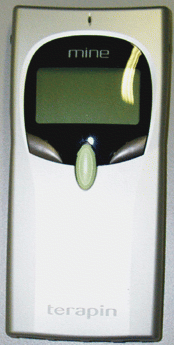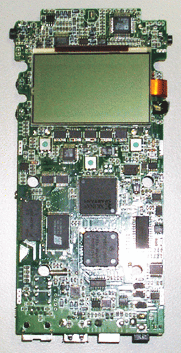Article: Meet the “mine” — a Linux-based data storage/record/playback device
Dec 5, 2002 — by LinuxDevices Staff — from the LinuxDevices Archive — 37 viewsWhat's a Terapin mine and what can I do with it?
The Terapin “mine” is a hand-held, Internet-enabled, personal data storage and record/playback device intended to meet a variety of professional or personal digital data needs. The simple-to-use Linux-powered device provides enough storage capacity in its built-in 10 gigabyte hard drive to hold thousands of digital photographs and audio… tracks, together with any other digital information its owner might want to carry around.
In addition to holding lots of data, the mine functions as a digital audio recorder/player (plays MP3s and WAV files) and digital photo album (displays JPEG, GIF, BMP, TIFF, CRW, and NEF's). With its USB port and PCMCIA card slot, the mine can also be used as an auxiliary storage device for a mobile computer (notebook or PDA), as a backup/restore device, or simply to transport a bunch of data from one place to another.
 Key features of the Terapin mine include . . .
Key features of the Terapin mine include . . .
- Powered by a Motorola PowerPC processor running an embedded Linux operating system
- Built-in 10 gigabyte hard drive
- 3 front-panel buttons and 3 side-mounted buttons provide all device controls
- File transfer is via USB or PCMCIA memory cards (PCMCIA adapters are available which accept CompactFlash and SmartMedia memory cards)
- Upload, download, and view digital images from digital cameras:
- Supports JPEG, GIF, BMP, TIFF, CRW (Canon Raw Format), and NEF(Nikon Electronic Files Format) digital file formats
- Can display photographs and graphic files on a TV or LCD projector
- Supports JPEG, GIF, BMP, TIFF, CRW (Canon Raw Format), and NEF(Nikon Electronic Files Format) digital file formats
- Audio Jukebox function:
- Supports MP3 (over 160 hrs.), WAV formats, and playlists
- Easily uploads and downloads MP3 files
- Supports MP3 (over 160 hrs.), WAV formats, and playlists
- Acts as a removable hard drive (compatible with Windows 98, 2000, ME, XP, Mac OS 9, and 0S X)
- Can be shared via local area network (LAN)
- Sends and receives email with attachments
- Voice recorder with over 20 hours of audio recording time (WAV format) via a mono audio-in port
- Built-in Scan Disk and Defragment Disk maintenance functions
- Provides hours of portable operation using four AA batteries or optional car power adapter, or may be powered with wall AC adapter
What makes it go?
Here's what's inside the mine, from a hardware perspective . . .
- Motorola PowerPC MPC823 processor
- Operates at 20MHz in “idle mode” and at 48MHz in “aggressive mode”
Memory:
- 1MB Flash — stores the boot-loader, compressed kernel, and compressed ramdisk
- 16MB SDRAM — contains the uncompressed kernel and provide space for running the application software
Hard drive:
- Built-in 10GB (or larger) IDE drive
- Stores the main application code and user data (MP3s, photo images, etc.)
- IDE HDD interface supports PIO mode 0-2, multiword DMA mode 1
Display:
- Built-in 128×64 pixel (4 lines x 16 characters) graphic LCD with backlighting
- Composite NTSC/PAL video output for display on TV
Audio:
- Stereo analog audio out for 16/20 bit WAVE and MP3 file playback
- Mono mic in — for 16-bit audio WAVE recording
- Hardware MP3 decode
Input/output ports:
- USB host and slave port (shared); full-speed host and slave hardware supported; voltage supply controlled
- PCMCIA:
- 16-bit interface, compliant with PCMCIA Type 2.1+ specs
- Fully buffered, 3.3V/5V-controlled, with port disable option
- Supports PCMCIA wireless network connection
- 16-bit interface, compliant with PCMCIA Type 2.1+ specs
- LAN: 10-baseT Ethernet (10 megabit/sec) with built-in RJ-45 connector
- Debug ports: RS232 (requires external RS232 driver), IrDA, JTAG, and DSD ports
Battery backed real-time clock:
- Provides up to 10 years clock operation
Mechanical:
- 7.1 x 3.5 x 1.1 in.
- 17 oz. (with 4 AA Alkaline batteries)
Power:
- Internal switching regulator circuits generate 3.3V @ 1A (max) and 5V @ 1A (max)
- Uses 4 replaceable AA batteries (alkaline, Ni-MH, or Lithium-ion), automobile power adapter, or wall AC power adapter
- Auto detects alkaline, Ni-MH, or Lithium-ion batteries (automatically disables recharging circuit when alkaline batteries are installed)
- Low battery detect and auto-shutdown functions preserve battery life and protect data
- Battery life — more than 1 hr for MP3 playback on 4 alkaline AA sized batteries; Li-Ion batteries can last 8 hours when idle, and 3-4 hours during typical usage (note: battery life varies according to how the mine is being used)
Buttons:
- 3 front-panel and 3 side-panel buttons provide all controls (includes 2 browser up/down buttons, intelligent on/off switch, digitally controlled volume)
 CPU:
CPU:
Additional photos of the mine are available here . . .
- the outside of the product package
- the contents of the product package
- front of the mine
- left side of the mine
- right side of the mine
- top of the mine, showing PCMCIA port
- bottom the mine, showing connectors for Ethernet, USB master, USB slave, and DC power
- cover off, showing hard drive
- front of the pcb
- back of the pcb
- bottom edge of the pcb
- left edge of the pcb
Software platform and SDK
The mine's embedded operating system is based on Linux kernel version 2.2.14, derived from MontaVista Software's embedded Linux distribution. Terapin's development team took care of the required kernel modifications and other issues specific to the mine's unique system requirements.
Regarding the display functionality, the mine has a small built-in graphic LCD panel which is used for simple text display during normal operation. The device can provide graphical output to a TV screen, a function which makes use of the open source Microwindows GUI framework.
Terapin's key objective in developing the mine was to ensure that it would easily interface with the widest possible range of popular digital cameras and mp3 players, allowing its users to download pictures from cameras and upload/download files to/from MP3 players. To facilitate this, Terapin's development team created a generic software layer for the mine which hides the specifics of the required protocols.
Other open source components have also been included in the mine's software stack, including a mail client, ftp client, ftp server, etc. For example, the mine Development Kit (mDK) describes how an Apache webserver can be installed in the device.
Why Linux?
What brought Terapin to select Linux to be the mine's embedded operating system?
“Linux is well supported globally by the open source community. We believe it is the best universal platform for embedded systems,” explained Terapin program manager Sidney Thong.
“With more and more emphasis on mobility, and wireless connections, I foresee that there will be more developments on wireless technology for embedded Linux devices,” Thong added. “Linux will continue to be a popular choice among developers.”
Creating a developer community
Terapin considers the mine to be much more than a device for storing images and MP3s, according to Thong. “It is a fully versatile portable storage device powered by an embedded Linux system, which can support many additional applications beyond those already developed,” he said.
By basing the mine's operation on an embedded Linux software platform (along with other open source software), Terapin hopes to enable the use of the mine as both a personal digital data bank, and as a device that can perform specific functions (much like a PDA), Thong added.
To encourage the world-wide developer community to create additional applications for the mine, Terapin has launched the mine Developer Network (mDN), where “Linux programmers, IT professionals, and embedded system enthusiasts” can obtain what they require to create mine apps. Through mDN, developers can obtain the mine Development Kit (mDK), a complete software development kit and related documentation (requires developer registration).
Also, a special promotional discount is currently being offered to mine application developers. Specifically, the mine is being made available to developers for $399 (USD) at Terapin's online store. The special price will be discontinued within several months, according to Thong.
Who is Terapin Technology and what's a terrapin?
Terapin Technology (formally known as Teraoptix) is a business division of Serial System Ltd, a company publicly listed on the Singapore stock exchange.
“Terapin draws its design inspiration from the terrapin, an aquatic turtle-like creature found in lakes and rivers of North America and Asia,” said Thong.
“The terrapin is funky and compelling, and in Chinese culture the terrapin is considered a symbol of good luck. The 'shell-like' packaging of the Terapin mine reminds us of the shell of the friendly terrapin. The name is memorable. It has family appeal, fits with the physical form — and kids will love it.”
This article was originally published on LinuxDevices.com and has been donated to the open source community by QuinStreet Inc. Please visit LinuxToday.com for up-to-date news and articles about Linux and open source.